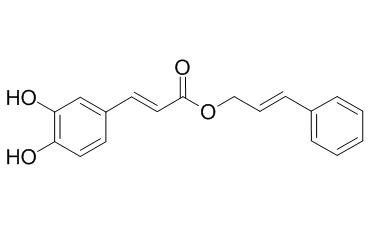Cinnamyl caffeate
Cinnamyl caffeate has cardiovascular protective effects, it can increase H9c2 cellular antioxidant potential, decrease intracellular calcium ion ([Ca2+]i) level, and prevent cell apoptosis; it possesses potent antiproliferative activity with the EC(50) value of 0.114 microM, toward colon 26-L5 carcinoma. Cinnamyl caffeate possesses potent NO inhibitory activity with the IC(50) value of 9.53 microM.
Inquire / Order:
manager@chemfaces.com
Technical Inquiries:
service@chemfaces.com
Tel:
+86-27-84237783
Fax:
+86-27-84254680
Address:
1 Building, No. 83, CheCheng Rd., Wuhan Economic and Technological Development Zone, Wuhan, Hubei 430056, PRC
Providing storage is as stated on the product vial and the vial is kept tightly sealed, the product can be stored for up to
24 months(2-8C).
Wherever possible, you should prepare and use solutions on the same day. However, if you need to make up stock solutions in advance, we recommend that you store the solution as aliquots in tightly sealed vials at -20C. Generally, these will be useable for up to two weeks. Before use, and prior to opening the vial we recommend that you allow your product to equilibrate to room temperature for at least 1 hour.
Need more advice on solubility, usage and handling? Please email to: service@chemfaces.com
The packaging of the product may have turned upside down during transportation, resulting in the natural compounds adhering to the neck or cap of the vial. take the vial out of its packaging and gently shake to let the compounds fall to the bottom of the vial. for liquid products, centrifuge at 200-500 RPM to gather the liquid at the bottom of the vial. try to avoid loss or contamination during handling.
Natural Product Communications2023, 18(9).
Free Radic Biol Med.2021, 166:104-115.
Int J Mol Sci.2020, 21(22):8816.
Korean J Acupunct2020, 37:104-121
Oncotarget.2017, 8(53):90925-90947
Neuroscience.2024, 559:77-90.
Green Chem.2023, 25:5222-5232
Heliyon.2023, 9:e21652.
Chem Pharm Bull (Tokyo).2017, 65(9):826-832
Appl. Sci. 2021, 11(17),7829
Related and Featured Products
Evid Based Complement Alternat Med. 2017;2017:7074147
Potential Protective Effects of Bioactive Constituents from Chinese Propolis against Acute Oxidative Stress Induced by Hydrogen Peroxide in Cardiac H9c2 Cells.[Pubmed:
28337227 ]
Chinese propolis (CP) is known as a health food but its beneficial effects in protecting cardiomyocytes remain elusive.
METHODS AND RESULTS:
Here, we investigated the effects of CP and its active compounds on hydrogen peroxide (H2O2) induced rats cardiomyocytes (H9c2) oxidative injury. Cell viability decreases induced by H2O2 were mitigated by different CP extracts using various solvents. From these active fractions, six active compounds were separated and identified. Among tested isolated compound, the cytoprotective activities of three caffeates, caffeic acid phenethyl ester (CAPE), benzyl caffeate (BZC), and Cinnamyl caffeate (CNC), exerted stronger effects than chrysin, pinobanksin, and 3,4-dimethoxycinnamic acid (DMCA). These three caffeates also increased H9c2 cellular antioxidant potential, decreased intracellular calcium ion ([Ca2+]i) level, and prevented cell apoptosis.
CONCLUSIONS:
Overall, the cardiovascular protective effects of the CP might be attributed to its caffeates constituents (CAPE, BZC, and CNC) and provide evidence for its usage in complementary and alternative medicine.
Biol Pharm Bull. 2003 Apr;26(4):487-91.
Caffeic acid phenethyl ester (CAPE) analogues: potent nitric oxide inhibitors from the Netherlands propolis.[Pubmed:
12673030]
The MeOH and water extracts of the Netherlands propolis were tested for their inhibitory activity toward nitric oxide (NO) production in lipopolysaccharide (LPS)-activated murine macrophage-like J774.1 cells.
METHODS AND RESULTS:
Both of the extract possessed significant NO inhibitory activity with IC(50) values of 23.8 and 51.5 microg/ml, respectively. Then 13 phenolic compounds obtained from the MeOH extract showing stronger NO inhibition were examined on their NO inhibitory activities. Caffeic acid phenethyl ester (CAPE) analogues, i.e., benzyl caffeate, CAPE and Cinnamyl caffeate, possessed most potent NO inhibitory activities with IC(50) values of 13.8, 7.64 and 9.53 microM, respectively, which were two- to four-fold stronger than the positive control N(G)-monomethyl-L-arginine (L-NMMA; IC(50), 32.9 microM). Further study on the synthetic analogues of CAPE revealed that both of 3-phenylpropyl caffeate (18; IC(50), 7.34 microM) and 4-phenylbutyl caffeate (19; IC(50), 6.77 microM) possessed stronger NO inhibitory activity than CAPE (10) and that elongation of alkyl side chain of alcoholic parts of caffeic acid esters enhance the NO inhibitory activity. In addition, it was found that CAPE analogues having longer carbon chain (>C(5)) in alcoholic part showed toxic effects toward J774.1 cells.
CONCLUSIONS:
This NO inhibitory effect may directly correlate with antiinflammatory properties of the Netherlands propolis.
J Ethnopharmacol. 2002 Apr;80(1):67-73.
Antiproliferative activity of the Netherlands propolis and its active principles in cancer cell lines.[Pubmed:
11891088]
METHODS AND RESULTS:
The MeOH extract of the Netherlands propolis showed promising antiproliferative activity toward highly liver-metastatic murine colon 26-L5 carcinoma with an EC(50) value of 3.5 microg/ml. Further, antiproliferative activity-guided purification of the MeOH extract led us to isolate four flavonoids (1-4), seven cinnamic acid derivatives (5-11) and two new glycerol derivatives (12, 13), whose structures were elucidated on the basis of spectral analysis. The isolated compounds were tested for their antiproliferative activity against murine colon 26-L5, murine B16-BL6 melanoma, human HT-1080 fibrosarcoma and human lung A549 adenocarcinoma cell lines. The benzyl caffeate (9), phenethyl caffeate (10) and Cinnamyl caffeate (11) possessed potent antiproliferative activities with EC(50) values of 0.288, 1.76 and 0.114 microM, respectively, toward colon 26-L5 carcinoma.
CONCLUSIONS:
These caffeates were considered to be active constituents of the Netherlands propolis in their antiproliferative activity. The antioxidative activity of these caffeates may play an important role in their antiproliferative activities.



